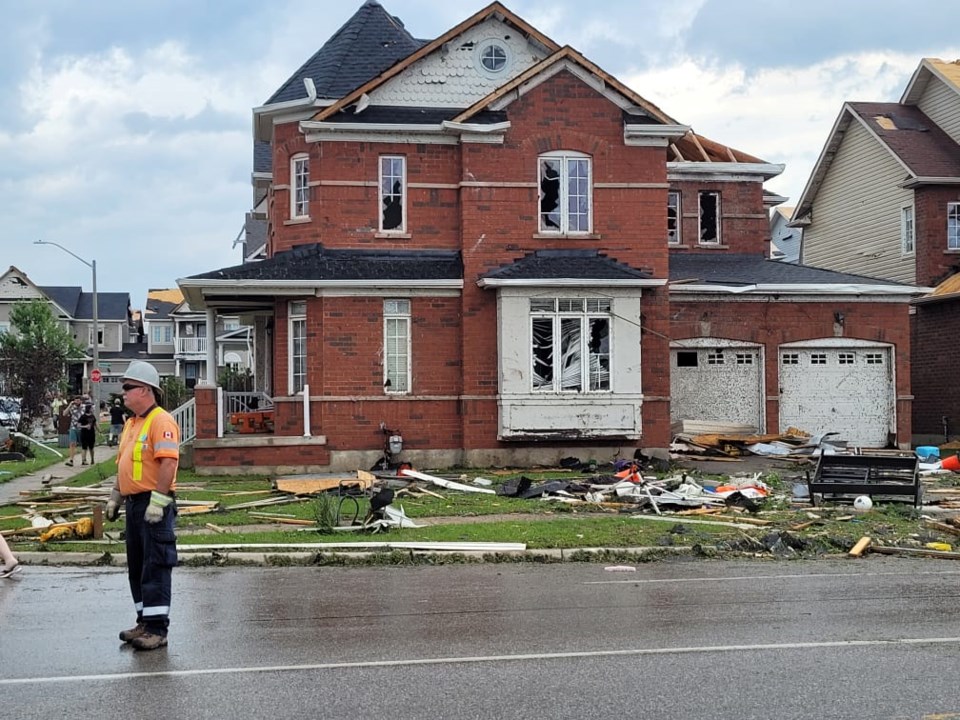Two demolition permits have been issued by the city for homes that will need to be rebuilt following Barrie’s EF2 tornado on July 15.
A memo from Michael Janotta, Barrie’s chief building official, updates the status of the 70 unsafe orders issued following the storm, which touched down in the city’s southeast end, with maximum wind speeds reaching 210 kilometres per hour, damaging hundreds of homes and some small businesses.
The tornado created extensive damage to many of the houses in the Mapleview Drive East/Prince William Way area which may have compromised the structural integrity of those buildings, Janotta’s memo says.
“The demolition permits issued are both for demolition to the first floor,” Janotta said in an email to BarrieToday. “So the first floor and foundation will remain and the remainder of the house will be reconstructed.”
Of the 70 unsafe orders issued, 39 houses are permitted entry by the occupants and/or contractor, 12 houses are deemed safe for continuous occupancy, and six building permit applications have been issued for repair of existing houses.
With the six repair permits, typical repairs include roof and wall reconstruction, with interior finishes such as drywall and flooring being removed and replaced, Janotta said.
“The scope of the repair depends on the extent of the damage,” he said.
Permitted entry means the building is considered structurally safe, but not necessarily habitable, Janotta said. Some restrictions —such as requirements for personal protective equipment (PPE) — have been identified in some of the reports due to the condition of the house, Janotta added.
The memo also covers expectations about how structures hold up in a tornado. The Ontario Building Code (OBC) defines the minimum standards for building construction.
“These minimum standards do not include resisting loads created by the effects of a tornado,”Janotta said in his memo. “The tornado event created loads on structures that are in excess of what they are intended to withstand.
“There is a difference between meeting the building code, which defines minimum construction requirements, and building to be tornado-resistant — which is a standard much higher than specified in the building code," he added.
It’s anticipated that city staff will be involved with work on the tornado-affected houses for a period of three months in assessing reports, reviewing drawings and issuing permits, and for a period of 12 to 16 months in inspecting the reconstruction.
Most houses are built with no specific consideration of wind loading, Janotta’s memo says. There are no predetermined load paths identified in this type of construction to deal with lateral loads and uplift loads, which are both caused by the effects of wind loading.
More stringent building requirements cannot be legally enforced until modifications are made to the OBC to mandate different construction techniques, Janotta’s memo says.
City councillors will consider a motion Monday night designed to change the Ontario Building Code.
An item for discussion from Coun. Natalie Harris requests that city staff partner with the Institute for Catastrophic Loss Reduction to ask the Ontario government for specific measures to modernize the OBC with respect to severe wind protection for new homes. This would include the requirement for the use of straps, clips or other mechanisms to better connect the roof, wall and foundation of homes.
Hurricane strapping or clips connect and strengthen wood-framed roofs and houses, with the most common ones made of galvanized steel or stainless steel. They are designed to help protect structures from severe weather.
“The addition of straps cost $100 to $500 per home, a small cost to prevent catastrophic damage and possibly loss of life,” Harris said.
Barrie city council does not have the authority to change the OBC, which must be amended by the province, although there is always an opportunity to talk at any time with Queen’s Park to ask for changes.
Harris’ motion also asks that in order to encourage installation of approved severe wind resilience features, city staff investigate the feasibility of introducing a rebate program for homeowners that did not experience damage resulting from tornado damage on July 15, and financial incentives for those whose homes were damaged, and report back to councillors.
“Having the City of Barrie adopt incentives (or) rebates for builders who use hurricane straps prior to the changes in the OBC will be a welcomed addition to the homes in our city,” she said.
And staff would be asked to work in collaboration with other agencies to develop an awareness campaign to inform Barrie residents about the risk of destructive tornadoes, options to assess risk of damage to their home and identify risk reduction and best practices, and again report back to councillors.
Harris also said there was a virtual roundtable meeting Wednesday involving Barrie-Innisfil MPP Andrea Khanjin, Barrie-Springwater-Oro Medonte MPP and Ontario Attorney General Doug Downey, representation from the Ministry of Municipal Housing and Affairs, Barrie Coun. Mike McCann, Greg Kopp of the Northern Tornadoes Project, Paul Kovacs and Dan Sandink of the Institute for Catastrophic Loss Reduction, Sandy Tuckey of the Simcoe County Home Builders Association, Chris Gariepy of Chris Gariepy Construction Advisors, and Ashley Polischuik of Squarefoot Commercial Group.
“I am also looking at approaching the federal government to make changes to their (building) codes as well,” Harris said. “We discussed the possibility of this during the meeting.”



